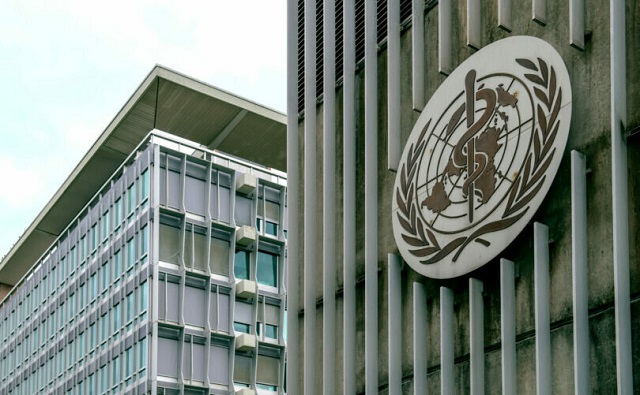Great Reset
Dr. Malone: ‘Disease X’ is manufactured by the WHO to drive fear and public compliance

Building of the World Health Organization in Geneva, Switzerland
From LifeSiteNews
Don’t be fooled by Disease ‘X’ or ‘Y’ or ‘Z.’ These aren’t real diseases. They are being weaponized to acceptance of the transfer of both funding and authority to an unelected globalist non-governmental organization – the WHO.
I have been working in the public health sector for over 30 years. This includes a fellowship at Harvard and numerous other courses on bioethics. In all that time, there has been one clear message: for the emotional and physical wellbeing of the public, the government and public health must not incite fear without cause, and that to do so is unethical and immoral, akin to yelling “fire” or “active shooter” in a crowded movie theater. That public trust requires transparency and truth telling on the part of public health officials and government.
The CDC codifies this basic premise in their public health risk communication statement:
Be first, be right, be credible. That’s the mantra for crisis communication. Health communicators, whenever a crisis occurs, always be prepared to provide information to help people make the best possible decisions for their health and well-being. [Emphasis added]
READ: WHO’s Dr. Tedros says new global pandemic is matter of ‘when’ not ‘if’ at 2024 Davos summit
In 2018, the World Health Organization came up with the idea of “Disease X,” which is a placeholder for a disease that could be a potential cause of a future major epidemic or a pandemic. The original idea being that planning for an (imaginary) “Disease X” would allow for scientists, public health officials, and physicians to design the best possible practices for a future epidemic or pandemic. They then formally added “Disease X” (an imaginary disease) to the top priority list of pathogens.
The idea behind Disease X was later weaponized to create a fog of fear in the public as well as governments. The weaponization started with COVID-19 communications. In a 2021 study, it was found that the “the only predictor of behavior change during COVID-19 was fear.” Despite their finding that such fear was related to a decrease in both emotional and physical wellbeing, the authors concluded that using fear to drive the public into compliance was the only path forward for public health. The authors write:
However, fear of COVID-19 was related to decreased physical and environmental wellbeing. Overall, these results suggest that ‘fear’ and anxiety at the current time have a functional role, and are related to increased compliance for improving public wellbeing.
‘Damn the torpedoes full steam ahead’
Without further questioning of the basic ethics behind using fear to drive compliance, this logic then became the consensus of public health officials and governments throughout the world. That being that the use of fear to get compliance for vaccines and vaccine mandates, vaccine passports, masking, lockdowns, social distancing, school closures, etc., was acceptable in the name of public health. That the decreased emotional and physical wellbeing of the general public by the promotion of fear tactics was an acceptable side effect.
Exit COVID-19… stage left. Enter ‘Disease X’… stage right
And just like that, “Disease X” has been substituted for COVID-19.
Without any qualms whatsoever, The World Health Organization (WHO) has gone from launching a global scientific process using Disease X as a model, to using “Disease X” as a propaganda driver to drive fear of an imaginary infectious disease. Then to use that fear to get public and governmental compliance for a new pandemic treaty, and more money for the WHO. Such weaponized fear (fearporn) also has been found to elicit more public compliance for public health measures, such as masking, social distancing, vaccines, and lockdowns.
The gradual shift was subtle. In April 2023, the WHO wrote:
Disease X represents the knowledge that a serious international epidemic could be caused by a pathogen currently unknown to cause human disease. The R&D Blueprint explicitly seeks to enable early cross-cutting R&D preparedness that is also relevant for an unknown ‘Disease X.’
In 2024, the WHO gave the general warning (without any data what-so-ever) that the imaginary Disease X could result in 20 times more fatalities than COVID-19.
Of course, there are some people who say this may create panic. It’s better to anticipate something that may happen because it has happened in our history many times, and prepare for it.
Bottom line is that Director-General Tedros now openly admits that the WHO is using fear to drive governments to open their pocket books and to drive compliance for the new pandemic treaty.
And the WHO’s fear mongering is working, the House recently introduced a new bill H.R.3832 – Disease X Act of 2023.
The bill reads:
This bill expands the priorities of the Biomedical Advanced Research and Development Authority (BARDA) to specifically include viral threats that have the potential to cause a pandemic.
In particular, the bill expands the scope of innovation grants and contracts that may be awarded by BARDA to specifically include those that support research and development of certain manufacturing technology for medical countermeasures against viruses, including respiratory viruses, with pandemic potential. It also expands BARDA’s authorized strategic initiatives to include advanced research, development, and procurement of countermeasures and products to address viruses with pandemic potential.
In order to understand the significance of this bill, it is important to understand what BARDA is:
(BARDA)’ is a U.S. Department of Health and Human Services (HHS) office responsible for the procurement and development of medical countermeasures, principally against bioterrorism, including chemical, biological, radiological and nuclear (CBRN) threats, as well as pandemic influenza and emerging diseases.
This bill is a sneaky backdoor to significantly expand the mission space of BARDA to include research into viruses. In the past, BARDA has been limited in their scope, so as to not compete with NIH. The expansion of yet another agency with very few limits on their scope is not in the public interest.
So, here is an easy ask. Contact your House representative and let them know how you feel about H.R.3832 – Disease X.
In the meantime, don’t be fooled by Disease “X” or “Y” or “Z.” These aren’t real diseases. They are made-up. They are being weaponized to gain compliance, drive fear, and to gain acceptance of the transfer of both funding and authority to an unelected globalist non-governmental organization – the WHO.
Yes, we have a problem with ongoing gain-of-function research and China is continuing on with its dangerous gain-of-function experiments. By all accounts, these are being conducted in poorly controlled laboratory environments. But such experiments aren’t limited to China; they are also happening in the USA. In 2023, Boston University School of Medicine scientists created a highly lethal SARS-CoV variant, which they then tested on mice.
Furthermore, the Biological Weapons Convention does not prohibit biological weapons, as an overlooked loophole allows for development, manufacture, and stockpiling of such for prophylactic, protective, or other peaceful purposes. The convention must be re-negotiated. The Biological Weapons Convention also does not adequately address gain-of-function research, which must to be banned worldwide.
These are concrete ongoing issues that the World Health Organization is not addressing. If the WHO’s motive is to stop future threat of infectious disease, why are they not working on these issues?
How far the WHO and public health has fallen…
Reprinted with permission from Robert Malone.
Digital ID
Canada releases new digital ID app for personal documents despite privacy concerns

From LifeSiteNews
The new GC Wallet is supposed to be a ‘foundational component’ of a controversial yet-to-come digital ID system.
Despite clear signs that most Canadians do not want a national digital ID, the Liberal government of Prime Minister Mark Carney has quietly released a new type of digital ID app on Google’s Play Store called GC Wallet.
The new app appeared on Google sometime late last week and was developed by Canada’s Employment and Social Development department. This is the same department, as reported by LifeSiteNews, that recently said it would move ahead with digital identification for anyone seeking federal benefits, including seniors on Old Age Security.
The new GC Wallet, say officials, is a “secure and convenient way to store and access your official digital credentials,” allowing users to keep important documents on it, such as temporary visas along with pilot licenses, and has an offline QR code function built in.
According to the government, the new GC Wallet is supposed to be a “foundational component” of a yet-to-come digital ID system that most likely will be expanded to a variety of documents.
The app was blasted on X by Kyle Kemper, the half-brother of former Prime Minister Justin Trudeau.
In an X post late last week, Kemper claimed the new app can “use your device’s camera to scan QR codes and import credentials issued by authorized institutions. Present your digital documents using dynamic QR codes or secure on-screen displays, making it easy to verify your identity and other information at airport boarding gates and other checkpoints.”
“The government of Canada has silently deployed a digital wallet on the Google Play Store for Digital ID. They have also cancelled an industry RFP process. I am digging into this and will offer detailed comments soon,” he wrote.
The GC Wallet is under development and, according to the feds, is “part of a limited Government of Canada pilot and is intended solely for use by approved participants.
The app is not available for broad public use at this time.
During COVID, the Canadian federal government released a digital-type app called ArriveCAN app for travel that was a form of digital ID. The app was riddled with technical glitches along with privacy concerns from users.
Last week, as reported by LifeSiteNews, without oversight from elected federal MPs, Canada’s Department of Immigration had research done to investigate a national ID system using digital passports for domestic use and how such a system would be enforced.
As reported by LifeSiteNews, the Canadian government hired outside consultants tasked with looking into whether or not officials should proceed with creating a digital ID system for all citizens and residents.
As per a May 20 Digital Credentials Issue memo, as noted by Blacklock’s Reporter, the “adoption” of such a digital ID system may be difficult.”
Digital IDs and similar systems have long been pushed by globalist groups like the World Economic Forum, an organization with which Carney has extensive ties, under the guise of ease of access and security.
One of Canada’s most staunchly pro-life MPs, Leslyn Lewis, recently warned Canadians to be “on guard” against a push by the ruling Liberal Party to bring forth Digital IDs, saying they should be voluntary.
Censorship Industrial Complex
Death by a thousand clicks – government censorship of Canada’s internet

The Justice Centre for Constitutional Freedoms announces its latest publication, Death by a thousand clicks: The rise of internet censorship and control in Canada, authored by veteran journalist and researcher Nigel Hannaford. The report outlines how recommendations from the Broadcasting and Telecommunications Legislative Review Panel in 2020 set the stage for a series of federal bills that have collectively transformed Canada’s once open internet into a state-managed digital environment that restricts what Canadians may access, share, and say online.
The report highlights the following federal legislation:
Online Streaming Act (C-11): Passed in 2023, this Bill gives the CRTC power to regulate online videos and other content, including material created by everyday Canadians. It also lets the government influence online “discoverability,” meaning it can push certain content to the top of your feeds while making other content harder to find.
Online News Act (C-18): Also passed in 2023, this Bill forces platforms to pay approved news outlets, a measure that led to increased dependence of media organizations on the government and widespread blocking of Canadian news as a result of Meta’s news ban on Facebook and Instagram.
Online Harms Act (C-63): Although this Bill was halted by the 2025 election, it would have empowered a new “Digital Safety Commission” to order content removals, demand platform data, levy severe financial penalties on service providers for non-compliance with regulations created by the federal cabinet, and impose house arrest on Canadians who had not been charged with or convicted of any crime. It also would have allowed the Canadian Human Rights Commission to pursue Canadians over non-criminal “discriminatory” speech, together creating a sweeping censorship regime under the guise of addressing so-called “harms” that were already illegal.
Strong Borders Act (C-2): Introduced in June 2025 and currently at second reading, this Bill authorizes law enforcement to obtain subscriber information and metadata without a warrant, chilling anonymous online expression and eroding digital privacy.
An Act respecting cyber security, amending the Telecommunications Act and making consequential amendments to other Acts (C-8): Introduced in April 2025 and now before committee, this Bill expands government access to private networks and enables federal officials to direct telecommunications providers to kick individual Canadians off the internet without due process or appeal.
Combatting Hate Act (C-9): Introduced in September 2025 and currently before Parliament, this Bill broadens “hate-propaganda” offences, removes Attorney General oversight for prosecutions, encourages widespread self-censorship, and makes Canada more like the United Kingdom, where thousands of citizens are arrested over their social media commentary.
Report author Nigel Hannaford said, “It is important for Canadians to know that these bills are not isolated technical updates. Together they form a coordinated shift toward state-managed digital speech.”
“If we value open debate, privacy, and democratic accountability, we need to repeal the laws already passed and stop the ones now before Parliament,” he added.
Benjamin Klassen, Research and Education Coordinator for the Justice Centre, said, “It is important Canadians stay informed about these important issues. An informed public is essential to a free society.”
“Through research reports like this one, our Education team works to explain complex legislation in a way that empowers Canadians to participate in the national debate around important policies and defend their rights and freedoms,” he added.
To protect free expression online, Canadians should demand the repeal of Bills C-11 and C-18, insist that MPs vote against Bills C-2, C-8, and C-9, and elect representatives committed to restoring a free and open internet.
-

 Censorship Industrial Complex1 day ago
Censorship Industrial Complex1 day agoDeath by a thousand clicks – government censorship of Canada’s internet
-

 Daily Caller1 day ago
Daily Caller1 day agoChinese Billionaire Tried To Build US-Born Baby Empire As Overseas Elites Turn To American Surrogates
-

 Automotive1 day ago
Automotive1 day agoPoliticians should be honest about environmental pros and cons of electric vehicles
-

 Great Reset1 day ago
Great Reset1 day agoViral TikTok video shows 7-year-old cuddling great-grandfather before he’s euthanized
-

 Digital ID1 day ago
Digital ID1 day agoCanada releases new digital ID app for personal documents despite privacy concerns
-

 Alberta1 day ago
Alberta1 day agoSchools should go back to basics to mitigate effects of AI
-

 Community1 day ago
Community1 day agoCharitable giving on the decline in Canada
-

 Bruce Dowbiggin1 day ago
Bruce Dowbiggin1 day agoNFL Ice Bowls Turn Down The Thermostat on Climate Change Hysteria


